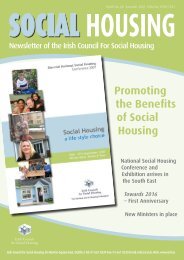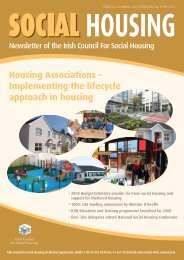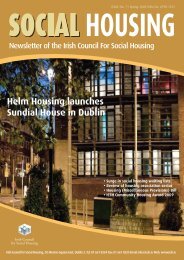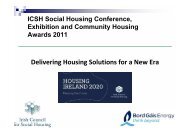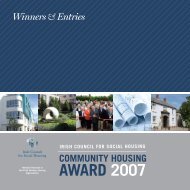National Housing Strategy for People with a Disability 2011 - 2016
National Housing Strategy for People with a Disability 2011 - 2016
National Housing Strategy for People with a Disability 2011 - 2016
Create successful ePaper yourself
Turn your PDF publications into a flip-book with our unique Google optimized e-Paper software.
10.16 The NIDD noted that of the people registered on this database, “more than 1 in 4people who had a moderate, severe or profound intellectual disability and who were aged35 years and over in 2009 lived in a home setting. … Because people <strong>with</strong> an intellectualdisability are living longer, the likelihood of their outliving their caregivers has increasedsubstantially in recent years. These data highlight the importance of planning <strong>for</strong> both thecohort on the NIDD who are ageing and <strong>for</strong> their carers.” 10810.17 For many adults, both <strong>with</strong> disabilities and <strong>with</strong>out, living as an adult in a familyhome is often suitable to their needs and the preferred choice of both the person and theirfamily. As illustrated in Table 10.1 109 above, 64% (16,742) of those registered on the NIDDlive at home <strong>with</strong> parents, siblings, relatives or foster parents. 49% (8,893) of people aged18 and over live in a home setting.10.18 It is vital that all relevant agencies work collaboratively to ensure that housingauthorities are aware of any person <strong>with</strong> an intellectual disability who is unlikely to continueliving in their existing accommodation, thus giving rise to a future housing need. This willbe facilitated through the development of good liaison arrangements between housingauthorities and relevant agencies, including service providers, through the establishment ofthe <strong>Housing</strong> and <strong>Disability</strong> Steering Groups. Furthermore, the strategic assessment ofhousing need protocol, which will provide <strong>for</strong> the sharing of in<strong>for</strong>mation between relevantagencies in relation to the nature and extent of need at local level, will facilitate better andmore strategic planning to address future housing need. This will assist housing authoritiesin invoking longer term housing strategies <strong>for</strong> people <strong>with</strong> any type of disability, thusassisting in the prevention of crisis housing situations. HSE statutory and non-statutoryservice provider consultative <strong>for</strong>a 110 at local, regional and national level will underpin thismulti agency approach.Advocates10.19 The important role of an advocate in provision of housing <strong>for</strong> people <strong>with</strong> disabilitieshas been recognised. In many instances, an advocate may be required to liaise <strong>with</strong>agencies on behalf of people <strong>with</strong> an intellectual disability due to the person’s lack of108Annual Report of the <strong>National</strong> Intellectual <strong>Disability</strong> Database Committee, 2009.109<strong>People</strong> represented in this table may not have a choice in all cases in choosing their main residentialcircumstances.110The core purpose of the HSE <strong>Disability</strong> Consultative Fora is to ensure that the needs of people <strong>with</strong> disabilitiesare identified, prioritised and addressed, <strong>with</strong>in available resources, in a systematic and equitable manneracross all the HSE areas.132



